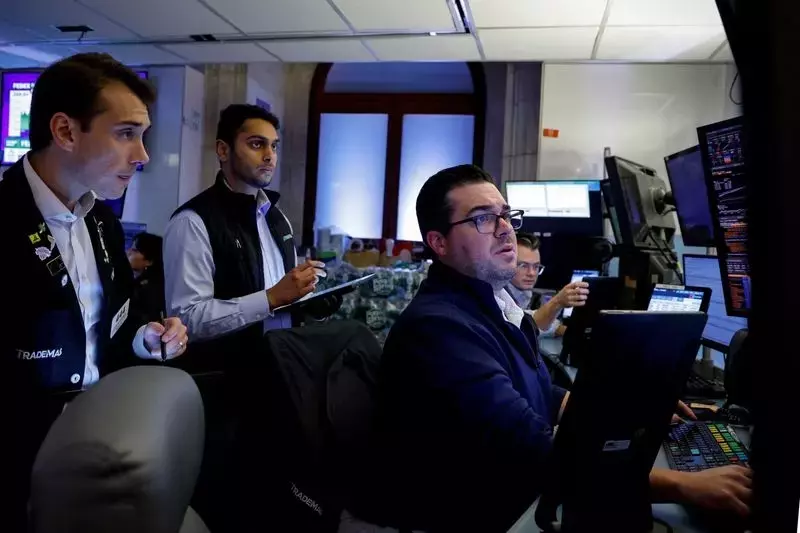Geopolitical Tensions and Labor Market Resilience: A Volatile Landscape for Investors
The benchmark S&P 500 and the Nasdaq traded near two-week lows on Wednesday as investors grappled with the potential escalation of geopolitical tensions in the Middle East. However, a survey alleviated concerns about a rapid cooldown in the U.S. labor market, providing a glimmer of optimism amidst the market volatility.Navigating Uncertain Terrain: Investors Brace for Potential Conflict Fallout
Geopolitical Tensions Weigh on Investor Sentiment
The markets were on edge as Israel and the U.S. vowed to retaliate after Iran's attack on Israel the previous day. This prompted the S&P 500 and the Nasdaq to log their biggest one-day drops in nearly a month. Investors were wary of the potential for further escalation in the region, which could disrupt global supply chains and economic stability.The Dow Jones Industrial Average managed to eke out a modest gain, while the S&P 500 and the Nasdaq Composite both experienced declines. The energy sector was a standout, with oil prices climbing more than 3% as traders factored in the possibility of supply disruptions from the oil-rich Middle East. Shares of major energy companies, such as Chevron and Exxon Mobil, rose in tandem.In contrast, defense stocks like Lockheed Martin and RTX remained relatively flat, despite the broader S&P 500 aerospace and defense index reaching a record high the day before. This suggests that investors were not yet fully pricing in the potential for increased military activity or defense spending in the region.Volatility Spikes as Investors Seek Clarity
The CBOE Volatility Index, Wall Street's fear gauge, hovered near a three-week high, reflecting the heightened uncertainty in the markets. Investors were grappling with the lack of information on the potential scale and duration of the Israeli response, which contributed to the overall market jitters."Sentiment is dominated by the risk of escalating conflict in the Middle East, and there is a lack of information on how strong the Israeli response is going to be. That's why the market is sort of not doing a lot," said Jay Hatfield, portfolio manager at InfraCap.Labor Market Resilience Offers a Glimmer of Hope
Amidst the geopolitical tensions, a survey provided some relief, indicating that the U.S. labor market conditions were not deteriorating as rapidly as feared. The report showed that private payrolls increased more than expected in September, suggesting that the labor market remained resilient.This positive data point helped mitigate the market's volatility, as investors weighed the potential impact of a strong labor market against the looming geopolitical risks. The odds of a quarter-percentage-point rate reduction at the Fed's November meeting also increased, reflecting the market's expectation of continued support from the central bank."The ADP report was strong, and that might be mitigating the volatility, because we're not in a complete information vacuum," Hatfield added.Sector Dynamics and Individual Stock Performance
The broader market performance was mixed, with eight of the 11 S&P 500 sectors trading lower. The Energy sector was a standout, hitting a more than one-month high and gaining 1.5%. This was likely driven by the surge in oil prices, which benefited companies like Chevron and Exxon Mobil.On the other hand, the Consumer Discretionary sector was the worst performer, down 1.2%, weighed down by the declines in Tesla and Nike. Tesla lost 4.7% after reporting third-quarter vehicle deliveries below estimates, while Nike slid 7.4% after withdrawing its annual revenue forecast as a new CEO was set to take charge.The healthcare sector also experienced significant volatility, with Humana plunging 21% after the company said it expects the total number of members enrolled in its top-rated Medicare Advantage plans for those aged 65 and above to decrease for 2025.Ongoing Developments and Investor Attention
As the day progressed, investors remained focused on comments from Fed policymakers, including Beth Hammack and Alberto Musalem, for any insights into the central bank's monetary policy stance. The market's attention also turned to the upcoming release of the September non-farm payrolls data, which could provide further clues about the strength of the labor market.Additionally, a dockworkers' strike on the East and Gulf coasts, which could cost the economy roughly $5 billion per day according to JPMorgan analyst estimates, entered its second day. Some companies, such as Walmart, Merit Medical Systems, and McCormick, had already planned for the strike, indicating their resilience in the face of potential supply chain disruptions.Overall, the markets navigated a volatile landscape, with investors grappling with the potential escalation of geopolitical tensions in the Middle East and the resilience of the U.S. labor market. As the situation continues to evolve, market participants will closely monitor the developments and their impact on the broader economic and financial landscape.

